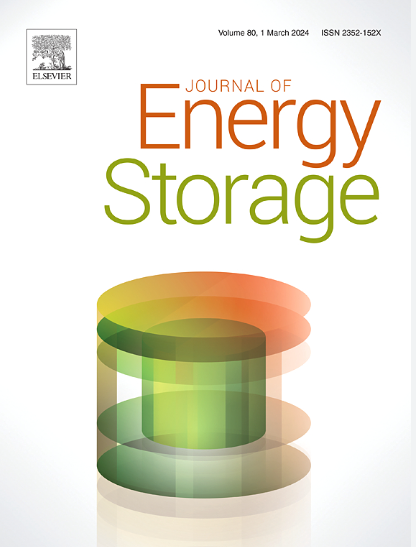优化氧化石墨烯还原:提高电化学性能的多步骤方法
IF 8.9
2区 工程技术
Q1 ENERGY & FUELS
引用次数: 0
摘要
本研究结合热法、化学法和多步法,对氧化石墨烯(GO)进行了还原。研究了还原方法对还原氧化石墨烯(rGO)样品结构和电化学性能的影响。还原方法不仅会影响碳层的含碳量和嵌层,还会显著影响微孔和中孔的孔隙特征,从而导致不同的电化学行为。尽管热还原氧化石墨烯具有高表面积,但其微孔的缺失和高缺陷密度阻碍了电荷的储存。化学还原消除了环氧树脂功能,部分恢复了sp2网络,促进了电荷的储存和传输。相比之下,多步还原技术产生了明显的嵌入层,消除了环氧树脂和羟基等功能,以恢复sp2网络,并引入了有利于改善电荷存储的显著微孔。在对称电池中,多级还原氧化石墨烯的比电容比热还原氧化石墨烯大5倍,比化学还原氧化石墨烯大2倍。此外,这种多步还原氧化石墨烯类型的电池提供了出色的速率能力,具有稳定的循环性能,并在0.9 kW kg - 1的比功率下提供17 Wh kg - 1的比能量。本文章由计算机程序翻译,如有差异,请以英文原文为准。

Optimizing graphene oxide reduction: A multistep approach for enhanced electrochemical performance
The present work reduces graphene oxide (GO) using thermal, chemical, and a multistep method by combining both techniques. The effects of reduction methodologies on the structure and electrochemical performance of the reduced graphene oxide (rGO) specimens are investigated. The reduction methodology not only influences the carbon content and intercalation of carbon layers but also significantly affects the porosity features in terms of micro and mesopores, resulting in different electrochemical behaviours. Despite the high surface area of thermally reduced graphene oxide, the absence of micropores and high defect density hinder charge storage. Chemical reduction eliminates epoxy functionalities to partially restore the sp2 network, promoting charge storage and transport. In contrast, the multistep reduction technique produces appreciable intercalation, eliminates functionalities such as epoxy and hydroxyl to restore the sp2 network, and introduces significant micropores beneficial to improved charge storage. The specific capacitance of multistep-reduced graphene oxide is found to be five times greater than thermally reduced graphene oxide and two times greater than chemically reduced graphene oxide in a symmetric cell. Furthermore, such a multistep rGO type of cell provides excellent rate capability with stable cyclic performance and delivers a specific energy of 17 Wh kg−1 at a specific power of 0.9 kW kg−1.
求助全文
通过发布文献求助,成功后即可免费获取论文全文。
去求助
来源期刊

Journal of energy storage
Energy-Renewable Energy, Sustainability and the Environment
CiteScore
11.80
自引率
24.50%
发文量
2262
审稿时长
69 days
期刊介绍:
Journal of energy storage focusses on all aspects of energy storage, in particular systems integration, electric grid integration, modelling and analysis, novel energy storage technologies, sizing and management strategies, business models for operation of storage systems and energy storage developments worldwide.
 求助内容:
求助内容: 应助结果提醒方式:
应助结果提醒方式:


